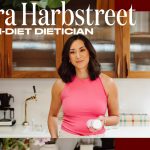Cara Harbstreet
Non-Diet Dietician
-
Morning Routine

She’s saying, “Let them eat cake.”
Cara Harbstreet is a non-diet dietician and the founder of Street Smart Nutrition, a foodie hub on a mission to make cuisine free of stress, shame, and bogus phrases like “guilt-free.”
Here’s how the Kansan jumpstarts her mornings, and why the first question towards any “healthy meal” planning should be, “What do I want to eat?”
6:30 A.M. I always plan on hitting snooze at least once. I’ve done a lot of work on values, and one of my biggest values is being comfortable. In the last year, I invested in really nice linens for my bed, so part of my morning routine is just being consciously comfortable in my bed.
7 A.M. I have 2 cats, so I feed [them] and do a bit of cleanup. Keeping my space minimally cluttered has been really helpful [while] working from home. Then coffee is a must-have. This time of year it’s always iced. In January, it would be piping. I’m a fan of podcasts like Food Psych, Food Heaven, and Maintenance Phase, so I usually play that in the background.
7:30 A.M. I check in with myself to gauge if I’m hungry. If so, I really love peanut butter and jelly sandwiches on English muffins [or] cereal. One of my most common breakfasts is leftovers. I’m not a huge fan of cleaning the kitchen more than I have to, so if it’s just reheating something, that’s one of my favorites! Then there are mornings where it takes a while for my appetite to rev up, and in that case, I wait a bit.
8 A.M. I practice intuitive eating, which is essentially a non-diet approach that prioritizes helpful behaviors versus weight loss or scale numbers. It returns the power and decision-making to you instead of living by restrictive guardrails around how we think we should be eating… The biggest thing I use as a catalyst for other healthy habits is vitamins, so I keep my vitamins from Health by Habit front and center. I’ve found that there are consistent gaps in my meal planning efforts, so vitamins really come in handy because they’re like a little insurance policy.
8:30 A.M. I check my inbox. As a small business owner, you’re constantly looking for next projects, so I’m [always] searching for new opportunities. I try to use the Pomodoro method where you dedicate a chunk of time to focus on a task, then take a break and move around. One thing that’s been helpful for flipping into work mode is changing where I’m at physically. I have a desk where I do the majority of my work, [but] if I’m having writer’s block or I’m procrastinating, I’ll either move to my kitchen counter or sit closer to the window. If the weather’s nice, I head out to my patio. It brings momentum back whenever I’m dragging.
10 A.M. I also work 1-on-1 with clients. Nutrition coaching is an important part of my schedule because it keeps me attuned to what people are asking. What I find is a common challenge is that, because so many of our recipes have been low-fat or no added sugar or this “healthified” version, a lot of us aren’t sure what we genuinely like. One of the first places I start with clients is asking questions [like], “How did you eat growing up? What are some of your favorite foods?” We’re not trying to force in ingredients. We’re really attuned to, “Is this something you can afford? Is this available in your area? What is your interest level in cooking?” Based on that, we find the “varsity bench” of go-to recipes, which can be modified so you don’t get bored with [eating] the same thing.
11 A.M. Up-and-coming dieticians have exposure to this non-diet approach that I really didn’t have. I have a past as an athlete and I experienced body image struggles and disordered eating. I always had this idea of, “There’s got to be something else, [an] alternative to this very structured, weight-centric way I was taught.” As I was exposed to that, it was sort of, “Oh, there it is!” That’s instilled a lot more empathy in how I practice because my eyes have been opened to the fact that everybody has different values [and] circumstances. Instead of saying there is only 1 right way to achieve and maintain good health, there’s actually an infinite number of ways. It really comes down to finding the sustainable habits that work for each person.



